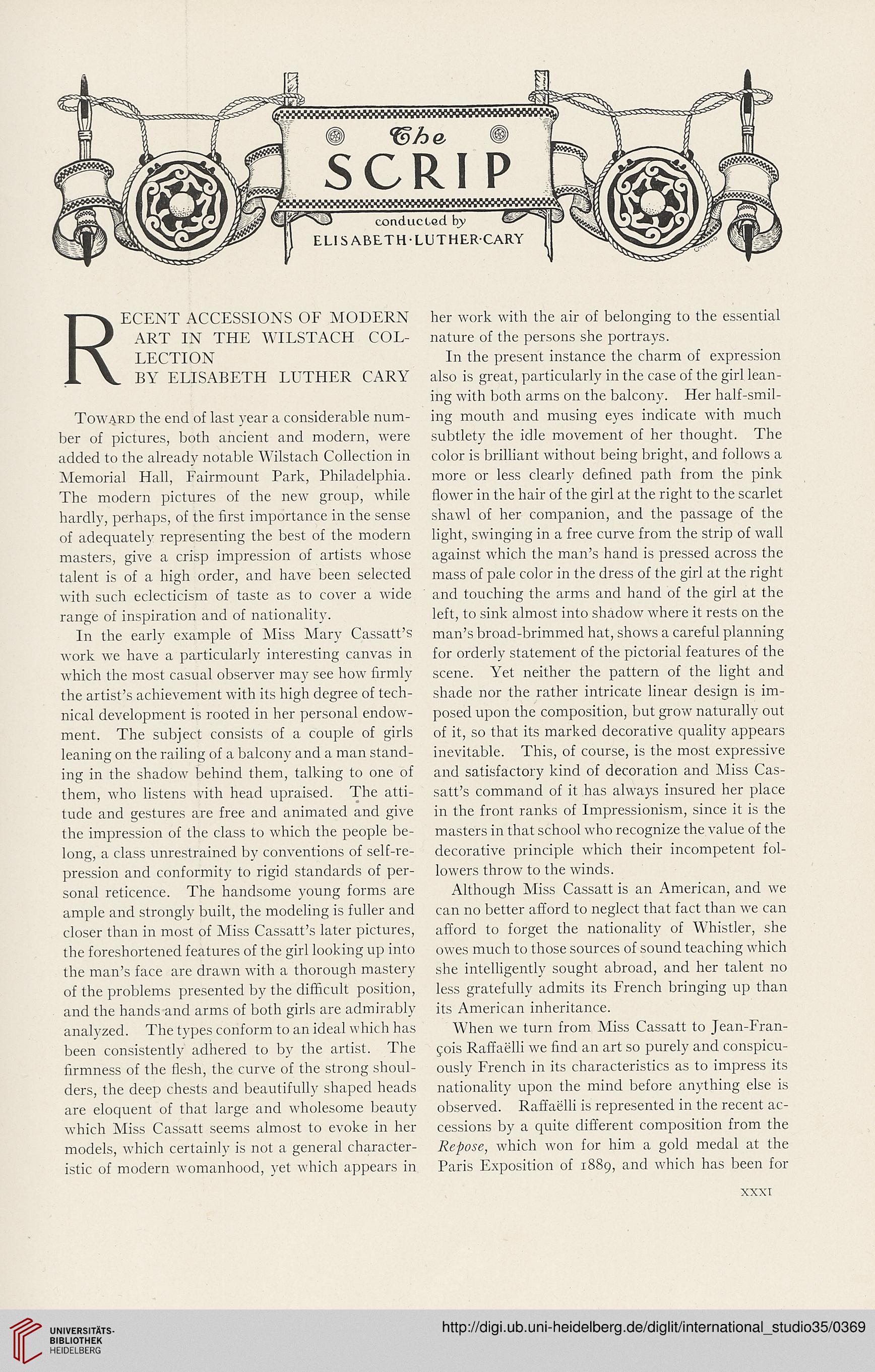ECENT ACCESSIONS OF MODERN
ART IN THE WILSTACH COL-
LECTION
BY ELISABETH LUTHER CARY
Toward the end of last year a considerable num-
ber of pictures, both ancient and modern, were
added to the already notable Wilstach Collection in
Memorial Hall, Fairmount Park, Philadelphia.
The modern pictures of the new group, while
hardly, perhaps, of the first importance in the sense
of adequately representing the best of the modern
masters, give a crisp impression of artists whose
talent is of a high order, and have been selected
with such eclecticism of taste as to cover a wide
range of inspiration and of nationality.
In the early example of Miss Mary Cassatt’s
work we have a particularly interesting canvas in
which the most casual observer may see how firmly
the artist’s achievement with its high degree of tech-
nical development is rooted in her personal endow-
ment. The subject consists of a couple of girls
leaning on the railing of a balcony and a man stand-
ing in the shadow behind them, talking to one of
them, who listens with head upraised. The atti-
tude and gestures are free and animated and give
the impression of the class to which the people be-
long, a class unrestrained by conventions of self-re-
pression and conformity to rigid standards of per-
sonal reticence. The handsome young forms are
ample and strongly built, the modeling is fuller and
closer than in most of Miss Cassatt’s later pictures,
the foreshortened features of the girl looking up into
the man’s face are drawn with a thorough mastery
of the problems presented by the difficult position,
and the hands and arms of both girls are admirably
analyzed. The types conform to an ideal which has
been consistently adhered to by the artist. The
firmness of the flesh, the curve of the strong shoul-
ders, the deep chests and beautifully shaped heads
are eloquent of that large and wholesome beauty
which Miss Cassatt seems almost to evoke in her
models, which certainly is not a general character-
istic of modern womanhood, yet which appears in
her work with the air of belonging to the essential
nature of the persons she portrays.
In the present instance the charm of expression
also is great, particularly in the case of the girl lean-
ing with both arms on the balcony. Her half-smil-
ing mouth and musing eyes indicate with much
subtlety the idle movement of her thought. The
color is brilliant without being bright, and follows a
more or less clearly defined path from the pink
flower in the hair of the girl at the right to the scarlet
shawl of her companion, and the passage of the
light, swinging in a free curve from the strip of wall
against which the man’s hand is pressed across the
mass of pale color in the dress of the girl at the right
and touching the arms and hand of the girl at the
left, to sink almost into shadow where it rests on the
man’s broad-brimmed hat, shows a careful planning
for orderly statement of the pictorial features of the
scene. Yet neither the pattern of the light and
shade nor the rather intricate linear design is im-
posed upon the composition, but grow naturally out
of it, so that its marked decorative quality appears
inevitable. This, of course, is the most expressive
and satisfactory kind of decoration and Miss Cas-
satt’s command of it has always insured her place
in the front ranks of Impressionism, since it is the
masters in that school who recognize the value of the
decorative principle which their incompetent fol-
lowers throw to the winds.
Although Miss Cassatt is an American, and we
can no better afford to neglect that fact than we can
afford to forget the nationality of Whistler, she
owes much to those sources of sound teaching which
she intelligently sought abroad, and her talent no
less gratefully admits its French bringing up than
its American inheritance.
When we turn from Miss Cassatt to Jean-Fran-
f ois Raffaelli we find an art so purely and conspicu-
ously French in its characteristics as to impress its
nationality upon the mind before anything else is
observed. Raffaelli is represented in the recent ac-
cessions by a quite different composition from the
Repose, which won for him a gold medal at the
Paris Exposition of 1889, and which has been for
XXXI





